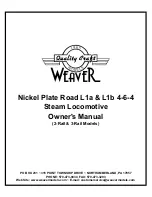
nosegear steering, as the larger gears (preferably metal) can handle any shock-loads better.
Retract valves, etc., can normally use any mini servos of at least 2kg torque.
Fuel System
: A pair of fibreglass moulded conformal main tanks (approx. 875cc each) are in-
cluded in the kit, which fit into the fuselage. Included is basic stopper hardware for these, but you
need to provide the brass tubing (1/8" O.D), kerosene stoppers (Dubro part #400), clunks and I.D
3 - 3.5mm Tygon tube.
We recommend a small 'hopper' tank between the main tanks and fuel pump, to prevent air bub-
bles getting to the turbine that could cause a 'flame-out'. Suitable tanks can easily be made from
any small 3 - 4oz tank, or you could use a BVM UAT, or the excellent small 'air-trap' from Intairco.
In addition you will need kerosene-proof fuel tube to suit your turbine, fuel filters etc.
If fitting a turbine at the higher end of the thrust range you can fit an additional tank of about 300cc
(10 fl.oz) in the fuselage, immediately in front of the rear cockpit bulkhead (under the hopper tank)
which will give you extended flight time.
Batteries/Switches
: The Hawk has no tendency to be tail-heavy, and with a 6-cell ECU/pump
battery (sub-C cells) and two 5-cell 600 mAH (AA sized) NiMH receiver packs no additional weight
was needed in the nose of the factory PST 600 powered Hawk. Depending on the recommenda-
tions of your R/C manufacturer, be sure to use a voltage regulator to limit the max. current to your
receiver ! One simple way to achieve this is to use the excellent (small & lightweight) Powerbox
'Sensor' switch which combines dual electronic 'fail-ON' switches for dual Rx batteries, with dual
inputs and outputs, and an integral 5.9v voltage regulator.
Building Instructions
There is no special sequence necessary for construction of the Hawk, and you can work on sev-
eral areas at the same time if you wish, making it a very quick plane to build. However it is nec-
essary to complete the wing joiners and wing bolts before installing the stabilisers, so that you
can use the wings as a guide to set the correct alignment of the stabs.
If you complete the assembly in the order shown below you will have no access problems, and by
fitting the nosegear unit last you can adjust the position and leg length as necessary to obtain the
correct ground angle (wing incidence) for easy take-offs and bounce-free landings.
Wing:
The wings are laminated from a lightweight fibreglass and foam sandwich, cured under vacuum,
and are painted in the molds in a single colour. Ailerons and flaps are elastic-hinged for your con-
venience. The hatches in the bottom skin for the servos are also elastic hinged and already cut out
for you at the factory. Likewise the main landing gear bays are already trimmed, and separate
molded covers are supplied.
The instructions below refer to the larger 2-piece ‘Sport’ wing, whereas the smaller ‘Scale‘ wing is
a one-piece type, so no wing joiners are needed. However, the assembly and servo installation is,
otherwise, similar for both wing versions.
Fox Composites Co., Ltd.
5







































